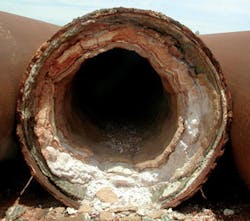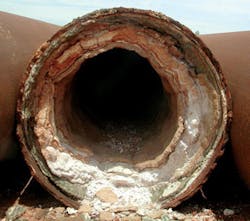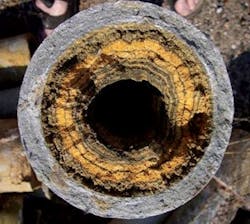Scale Factors: Reducing Corrosion in Pipelines with Electronic Water Treatment
By Jan de Baat Doelman
Increasing pressure loss in the pipeline is often caused by scale corrosion or product fouling of the internal surfaces. This condition slows transmission and distribution capacity and can require more than just routine maintenance if it remains unaddressed. Interior corrosion, fouling and leakage in pipeline systems will adversely impact bottom-line operations.
If corrosion and fouling on part of the pipeline is evident, the chances are it is occurring throughout the length of the pipes. If the corrosion is left untreated, it can weaken the pipe walls to the extent that the entire pipeline will need to be completely replaced.
The ideal solution is to treat pipelines so that fouling and corrosion do not occur. Hard water is corrosive to metallic tubes and contributes to fouling and bacterial contamination that eats away at the piping surfaces. Leaks and damage, pitting and obstructive buildup all require frequent maintenance.
Common fouling mechanisms are:
- Particulate fouling: This results from sediment of dust, rust, fine solids, and other entrained solids.
- Crystallization fouling: Calcium carbonate is the predominant component of the hard and tenacious scale deposit from water and is particularly apparent in processes involving heat transfer. A concentration of dissolved solids by repeated partial evaporation of the water is the main factor that causes calcium carbonate scale. Even soft water will eventually become scale-forming when concentrated numerous times (i.e., two, three, four, or even higher).
- Biological fouling: This occurs when biological organisms grow on heat exchanger surfaces. Problems arise from algae and other microbes such as barnacles and zebra mussels. At certain times of the year when microbes are said to bloom, colonies several inches thick may grow across the heat exchanger surface, affecting thermal performance.
- Chemical reaction fouling: This type of fouling occurs when the depositions are formed as a result of chemical reaction.
- Corrosion fouling: This results from a chemical reaction that involves the heat exchanger surface material.
Cleaning
Some popular methods of removing fouling from pipelines include:
- Chemical cleaning using solvent or chemicals
- High-velocity cleaning using water jets
- Electronic water treatment
Scaling deposits are common in flowlines subject to changes in pressure or temperature. Regardless of how hard water effects are achieved, the outcome is the same: Scale formation results in reduced diameter or blocked pipes. Pipework scale reduces the available cross-section area, and fluids are affected by increased pipewall friction. A larger, more power-consuming pump will be required to maintain throughput volumes, but this may provide only a temporary solution to the problem. Plants that need to be shut down for cleaning cost money.
The formation of a thin uniform layer of scale or wax temporarily can reduce steel corrosivity, but stagnant conditions eventually develop under the deposit, and electrochemical reactions will corrode the steel surfaces. The result can be fluid leaks and equipment failure, which is potentially very dangerous. Not only is plant and product integrity at risk, but personnel health and safety may be compromised. Safety valves or emergency process sensors that are fouled may not operate in an emergency.
To explain the effect of electronic scale removal, it is first important to understand the major factors that cause scale. Although scale can be a complex of many minerals, calcium carbonate is the most prevalent in industrial processes.
Super Saturation
Aqueous solutions can become supersaturated, which means that they contain higher concentrations of dissolved solute than their equilibrium concentration. Such solutions are not stable and are easily triggered into dropping back to saturation level, forcing the dissolved compound to precipitate. Even when a bulk solution is less than fully saturated, scale formation can occur spontaneously due to localized super saturation, at a surface for example.
pH Effect
The pH of the solution is directly related to its acid content (typically carbonic acid). The higher the acid content, the lower the pH number. The solubility of calcium carbonate is directly affected by the pH of the water. If the pH of the water is decreased, more calcium carbonate solid can be dissolved. Conversely, if the pH of the water rises, it will force calcium carbonate out of solution and scale deposits will therefore form.
Temperature Effect
Gases in general -- specifically carbon dioxide -- are less soluble in water at high temperatures. Therefore, as the temperature rises, the dissolved carbon dioxide decreases. This increases the pH of the fluid, reducing the solubility of the calcium carbonate and forcing the mineral to deposit.
Pressure Effect
Carbon dioxide and gases in general are more soluble under higher pressure. Therefore, as the pressure drops, carbon dioxide gas will be forced out of solution, lowering the carbonic acid concentration. The rise in pH is associated with a drop in calcium carbonate solubility, leading to the formation of mineral scale deposits.
Electronic Water Conditioning
Electronic Water Treatment (EWT) is a non-invasive system utilizing a solenoid coil or coils wrapped around the pipework to be treated. A continuous frequency-changing signal generator, within a specified range, supplies current to the coils. The pulse-shaped current creates an induced electric field, concentric around the axis inside the pipe. As a consequence of this arrangement, any charged particle or ion moving within the field experiences a so-called Lorentz force generated by the interaction between charged particles and magnetic and electric fields.
The treatment influences the initial nucleation, resulting in crystals that do not "stick" together. Untreated water builds up matted structures that continuously grow. This treatment creates idiomorphic, scattered crystals, which do not form matted structures. They have a rotundas shape, which means that they have a larger volume in relation to a smaller surface. This feature makes them sensitive to water currents, and they are easily flushed out of the pipeline.
As no new scale layers are formed, the sheer force of the water flow will gradually remove existing layers of scale. The ability to adjust power, frequency and coil configurations of EWT products onsite enables performance to be optimized with no downtime and no pipe replacement.
Biological Fouling
The impact of zebra mussels extends from the Great Lakes watershed to the mouth of the Mississippi River. The mussels affect industry by clogging pipes and intake structures. Crustaceans and zebra mussels are similar in the way they use calcium -- a key component of pipe scaling. They convert calcium in a free ion form to calcium carbonate to construct their shell or exoskeleton. A study undertaken by Aquatic Sciences Inc., an international underwater inspection service, found that EWT technology was successful in removing calcium carbonate and thereby drastically reducing the level of zebra mussel infestation.
Fouling in Heat Exchangers
In processing industries, the fouling of heat exchangers is a chronic operating problem. Costs due to additional fuel consumption and maintenance, loss of production, etc., have been estimated as 0.25% of the gross national product (GNP) of industrialized countries. EWT offers an environmental, effective and cost-saving method of reducing fouling on heat exchangers, which can only prove a win-win-win scenario for all.
About the Author: Jan de Baat Doelman is the inventor and CEO of the Scalewatcher Group. Scalewatcher is a manufacturer of electronic, de-scaling technology used throughout Europe, Asia, and Africa with assembly facilities in the Netherlands, S.E. Asia, and the U.S.
More WaterWorld Current Issue Articles
More WaterWorld Archives Issue Articles


